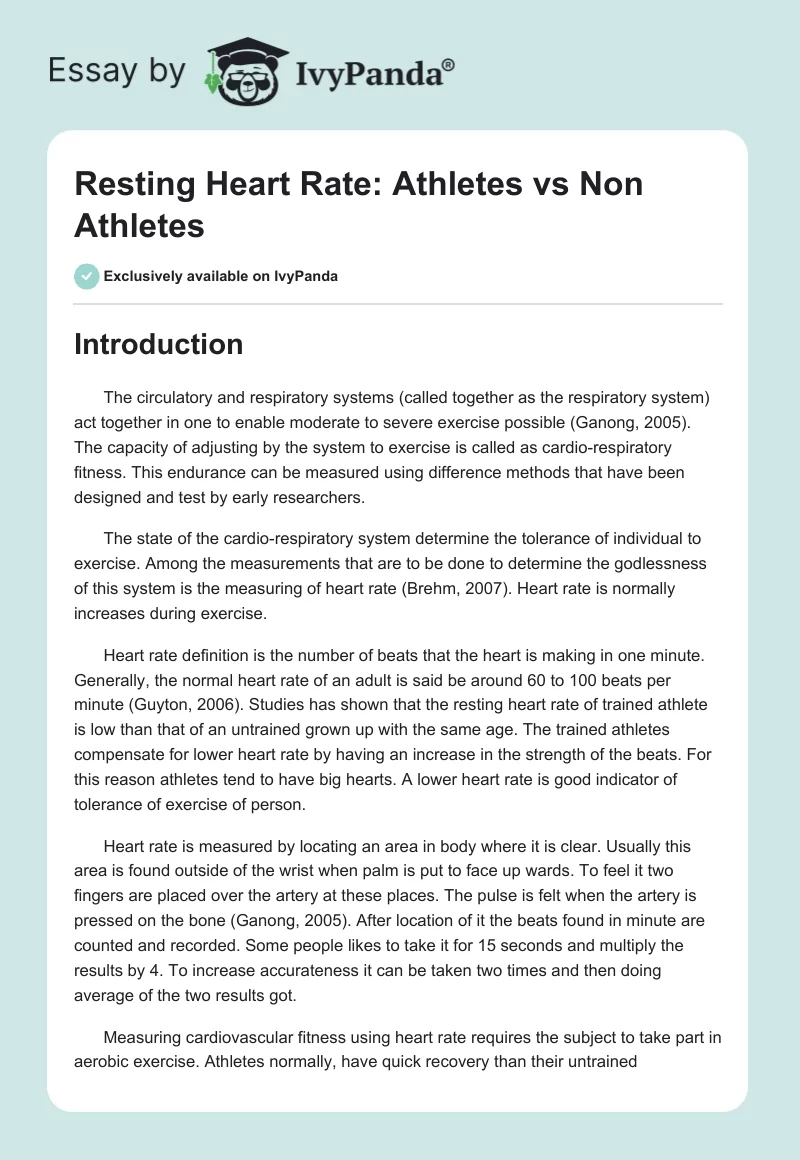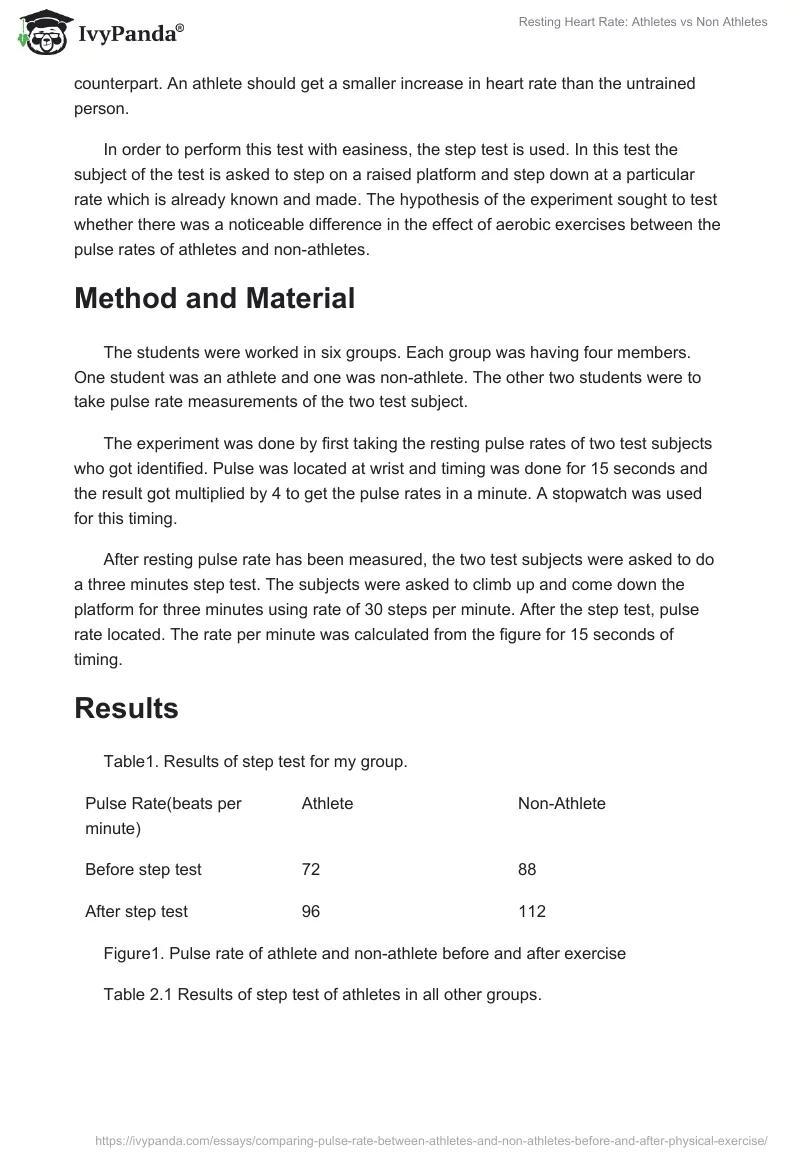Introduction
The circulatory and respiratory systems (called together as the respiratory system) act together in one to enable moderate to severe exercise possible (Ganong, 2005). The capacity of adjusting by the system to exercise is called as cardio-respiratory fitness. This endurance can be measured using difference methods that have been designed and test by early researchers.
The state of the cardio-respiratory system determine the tolerance of individual to exercise. Among the measurements that are to be done to determine the godlessness of this system is the measuring of heart rate (Brehm, 2007). Heart rate is normally increases during exercise.
Heart rate definition is the number of beats that the heart is making in one minute. Generally, the normal heart rate of an adult is said be around 60 to 100 beats per minute (Guyton, 2006). Studies has shown that the resting heart rate of trained athlete is low than that of an untrained grown up with the same age. The trained athletes compensate for lower heart rate by having an increase in the strength of the beats. For this reason athletes tend to have big hearts. A lower heart rate is good indicator of tolerance of exercise of person.
Heart rate is measured by locating an area in body where it is clear. Usually this area is found outside of the wrist when palm is put to face up wards. To feel it two fingers are placed over the artery at these places. The pulse is felt when the artery is pressed on the bone (Ganong, 2005). After location of it the beats found in minute are counted and recorded. Some people likes to take it for 15 seconds and multiply the results by 4. To increase accurateness it can be taken two times and then doing average of the two results got.
Measuring cardiovascular fitness using heart rate requires the subject to take part in aerobic exercise. Athletes normally, have quick recovery than their untrained counterpart. An athlete should get a smaller increase in heart rate than the untrained person.
In order to perform this test with easiness, the step test is used. In this test the subject of the test is asked to step on a raised platform and step down at a particular rate which is already known and made. The hypothesis of the experiment sought to test whether there was a noticeable difference in the effect of aerobic exercises between the pulse rates of athletes and non-athletes.
Method and Material
The students were worked in six groups. Each group was having four members. One student was an athlete and one was non-athlete. The other two students were to take pulse rate measurements of the two test subject.
The experiment was done by first taking the resting pulse rates of two test subjects who got identified. Pulse was located at wrist and timing was done for 15 seconds and the result got multiplied by 4 to get the pulse rates in a minute. A stopwatch was used for this timing.
After resting pulse rate has been measured, the two test subjects were asked to do a three minutes step test. The subjects were asked to climb up and come down the platform for three minutes using rate of 30 steps per minute. After the step test, pulse rate located. The rate per minute was calculated from the figure for 15 seconds of timing.
Results
Table1. Results of step test for my group.
Figure1. Pulse rate of athlete and non-athlete before and after exercise
Table 2.1 Results of step test of athletes in all other groups.
Table2.2 Results of step test for non-athlete in all other groups
Table 3. Average and difference of pulse rates before and after exercise
Figure 2. Average and difference of pulse rate before and after exercising.
Conclusions
The hypothesis of the experiment sought to test whether there was a notice able difference in the effect of aerobic exercises between the pulse rates of athletes and non-athletes. The results go from the experiment surely gave positively support to the hypothesis. Though it is, the difference in this experiment is less; it is possible to make a conclusion using the data. The results showed there was small variation between the athletes and non-athletes.
These findings get supported by early research. In this experiment the small increase may be because of mistake of experiment such as timing mistakes. All the test subject had heart rates below 100 beats in a minute. An interesting observation is that non-athletes had higher heart rates at rest. This may be to the fact that they do not exercise regularly like the athletes. To reduce this difference they should do suitable exercise good for them.
Several factors affect the heart rate of an individual. These factors include the time of day it is taken and eating of some substances. Pulse is usually at resting point early in the morning or after waking up. Coffee is also may increase heart rate. Smoking may also gives an abnormally high heart rate.
To obtain more accurate results the factors should be considered. Eligibility criteria for the experiment should also be checked at so that in future experiments, students who get to this group can not be used as test subjects. Use of digital pulse measuring machines may also be put in use in the future.
References
Brehm, B. (2007). Heart Rate and Exercise Training. Fitness Management.
Ganong, F. William (2005). Ganong’s Review of Medical Physiology, (22nd Ed), NY: McGraw-Hill.
Guyton, C. Arthur & Hall, E. John. (2006). Guyton Textbook of Medical Physiology, (11th Ed), NY: Saunders.



